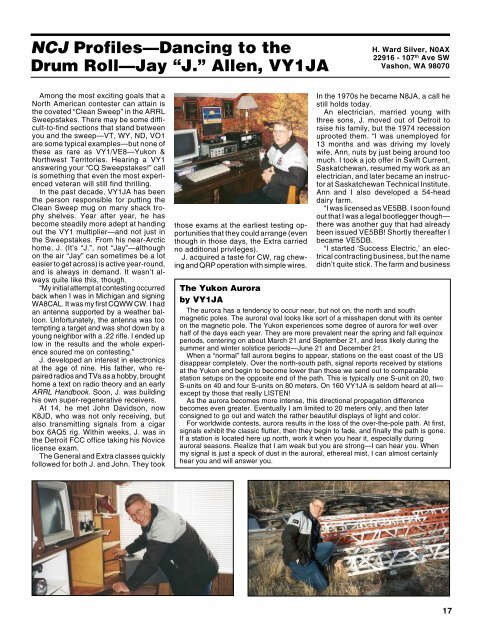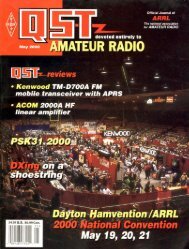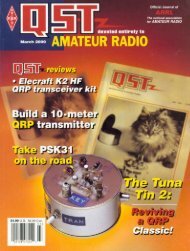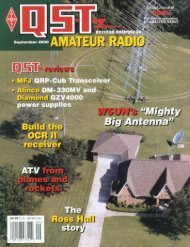September/October 2000 NCJ
September/October 2000 NCJ
September/October 2000 NCJ
Create successful ePaper yourself
Turn your PDF publications into a flip-book with our unique Google optimized e-Paper software.
<strong>NCJ</strong> Profiles—Dancing to theDrum Roll—Jay “J.” Allen, VY1JAH. Ward Silver, N0AX22916 - 107 th Ave SWVashon, WA 98070Among the most exciting goals that aNorth American contester can attain isthe coveted “Clean Sweep” in the ARRLSweepstakes. There may be some difficult-to-findsections that stand betweenyou and the sweep—VT, WY, ND, VO1are some typical examples—but none ofthese as rare as VY1/VE8—Yukon &Northwest Territories. Hearing a VY1answering your “CQ Sweepstakes!” callis something that even the most experiencedveteran will still find thrilling.In the past decade, VY1JA has beenthe person responsible for putting theClean Sweep mug on many shack trophyshelves. Year after year, he hasbecome steadily more adept at handingout the VY1 multiplier—and not just inthe Sweepstakes. From his near-Arctichome, J. (It’s “J.”, not “Jay”—althoughon the air “Jay” can sometimes be a loteasier to get across) is active year-round,and is always in demand. It wasn’t alwaysquite like this, though.“My initial attempt at contesting occurredback when I was in Michigan and signingWA8CAL. It was my first CQWW CW. I hadan antenna supported by a weather balloon.Unfortunately, the antenna was tootempting a target and was shot down by ayoung neighbor with a .22 rifle. I ended uplow in the results and the whole experiencesoured me on contesting.”J. developed an interest in electronicsat the age of nine. His father, who repairedradios and TVs as a hobby, broughthome a text on radio theory and an earlyARRL Handbook. Soon, J. was buildinghis own super-regenerative receivers.At 14, he met John Davidson, nowK8JD, who was not only receiving, butalso transmitting signals from a cigarbox 6AQ5 rig. Within weeks, J. was inthe Detroit FCC office taking his Novicelicense exam.The General and Extra classes quicklyfollowed for both J. and John. They tookthose exams at the earliest testing opportunitiesthat they could arrange (eventhough in those days, the Extra carriedno additional privileges).J. acquired a taste for CW, rag chewingand QRP operation with simple wires.In the 1970s he became N8JA, a call hestill holds today.An electrician, married young withthree sons, J. moved out of Detroit toraise his family, but the 1974 recessionuprooted them. “I was unemployed for13 months and was driving my lovelywife, Ann, nuts by just being around toomuch. I took a job offer in Swift Current,Saskatchewan, resumed my work as anelectrician, and later became an instructorat Saskatchewan Technical Institute.Ann and I also developed a 54-headdairy farm.“I was licensed as VE5BB. I soon foundout that I was a legal bootlegger though—there was another guy that had alreadybeen issued VE5BB! Shortly thereafter Ibecame VE5DB.“I started ‘Success Electric,’ an electricalcontracting business, but the namedidn’t quite stick. The farm and businessThe Yukon Auroraby VY1JAThe aurora has a tendency to occur near, but not on, the north and southmagnetic poles. The auroral oval looks like sort of a misshapen donut with its centeron the magnetic pole. The Yukon experiences some degree of aurora for well overhalf of the days each year. They are more prevalent near the spring and fall equinoxperiods, centering on about March 21 and <strong>September</strong> 21, and less likely during thesummer and winter solstice periods—June 21 and December 21.When a “normal” fall aurora begins to appear, stations on the east coast of the USdisappear completely. Over the north-south path, signal reports received by stationsat the Yukon end begin to become lower than those we send out to comparablestation setups on the opposite end of the path. This is typically one S-unit on 20, twoS-units on 40 and four S-units on 80 meters. On 160 VY1JA is seldom heard at all—except by those that really LISTEN!As the aurora becomes more intense, this directional propagation differencebecomes even greater. Eventually I am limited to 20 meters only, and then laterconsigned to go out and watch the rather beautiful displays of light and color.For worldwide contests, aurora results in the loss of the over-the-pole path. At first,signals exhibit the classic flutter, then they begin to fade, and finally the path is gone.If a station is located here up north, work it when you hear it, especially duringauroral seasons. Realize that I am weak but you are strong—I can hear you. Whenmy signal is just a speck of dust in the auroral, ethereal mist, I can almost certainlyhear you and will answer you.17
















